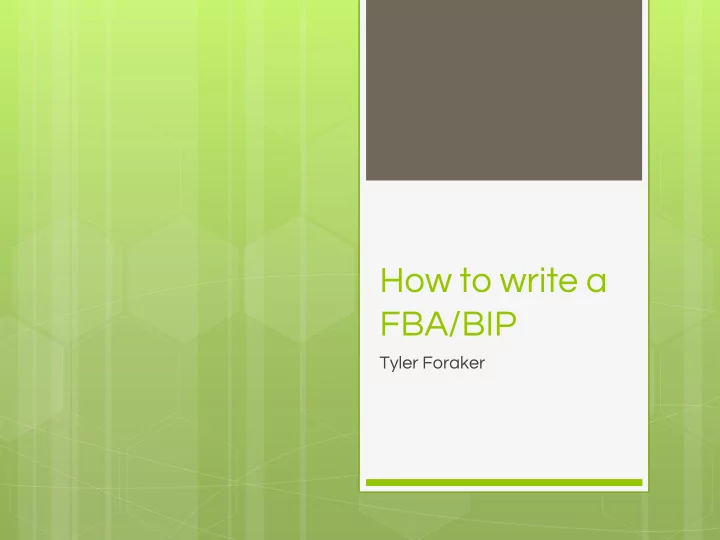

How to write a FBA/BIP Tyler Foraker
What is a FBA? ○ Assessment looking beyond the behavior ○ Social, cognitive and environmental factors are studied ○ Factors are compared to the occurrence of the problem behavior ○ What is the function of the behavior?
What is a BIP? ○ Behavior Intervention Plan ○ Intensive intervention and monitoring ○ Increase Support ○ Individual plan for success ○ Involves teachers, parents, student, and support staff
Why do we care?
Why do we care?
Steps to conduct an FBA ○ 1. Verify the seriousness of the problem ○ 2. Define the problem behavior ○ 3. Collect information about the problem ○ 4. Analyze the information collected ○ 5. Hypothesis on function of behavior ○ 6. Verify the hypothesis ○ 7. Develop and Implement BIP ○ 8. Evaluate fidelity of the plan ○ 9. Evaluate the Effectiveness of the plan ○ 10. Modify the plan
Verify/Define the Behavior Problem Behavior Concrete Definition Tyler is aggressive Tyler hits other students during PE when he does not get his way Tommy is disruptive Tommy blurts out and make irrelevant and inappropriate comments during the lesson Sue is hyperactive Sue moves around without permission. Sue completes only portions of her assignments.
Questions to ask 1. Does the student’s behavior significantly differ from that ○ of his/her classmates? 2. Does the behavior lessen the possibility of successful ○ learning for the student/others? 3. Have past efforts to address the behavior using standard ○ interventions been unsuccessful? 4. Does the behavior represent a skill or performance ○ deficit, rather than a cultural difference? 5. Is the behavior serious, persistent, chronic, or a threat to ○ the safety of the student or others? 6. If the problem persists, is some form of disciplinary action ○ likely?
Collect Information ○ Times when the behavior occurs ○ Specific Location ○ Conditions ○ Individuals Present ○ Events before/after the behavior ○ Common settings ○ Other noted behaviors
Hypothesize why the behavior is occurring? ○ Function- to get/seek something or to avoid/escape something undesired ○ Skill Deficit- a behavior or academic skill that the student does not know how to perform ○ Performance Deficit- a behavior or academic skill the student can do, but does not consistently perform.
Function of Behavior Positive Reinforcement: Negative Reinforcement : ∙ Social attention or ∙ Escape from activities or people ∙ Sensory ∙ Access to materials ∙ Pain ∙ Sensory Stimulation “TO GET” “TO GET OUT OF” Setting Target Function Antecedent Events Behavior (Reinforcer)
Develop a BIP ○ Proactive: What environmental adjustments will be used to make the student’s problem behavior unnecessary? ○ Educative: What behaviors (skills) will be taught to replace or meet the same function as the student’s problem behavior and improve his or her ability to function more effectively? ○ Effective: How will consequences be managed to ensure the student receives rein forcers for positive behavior, not problem behavior?
BIP Model Desired Reinforcement Behavior Setting Target Reinforcement (< Event Antecedent Behavior R+) Acceptable Reinforcement Alternative (Function) Antecedent Modifications
BIP Examples ○ Terry is a junior high student with a moderate intellectual disability. Terry frequently throws books on the floor during transitions between classes. Terry’s paraprofessional must stop and clean up all the papers and books before proceeding to the next work assignment.
Example Plan for Terry ○ Provide a written or picture schedule and refer to it throughout the day. ○ Prepare Terry for changes, noting them on the schedule. ○ Teach Terry to ask for clarification regarding changes and reward Terry for smooth transitions. ○ Have Terry pick up materials after finishing the next activity.
Example BIP Teach Terry Accepts Positive feedback to ask changes questions Terry throws Pick up materials later Changes in materials schedule Earns computer time Teach Terry to ask questions Schedule noting changes
Monitor the Plan ○ Continue to monitor frequency and duration of the behavior ○ Use same data collection techniques in order to use original data as a baseline ○ If the plan is working, keep it. ○ If the plan needs adjusting, then keep working with it until a fix is found
References ○ http://www.pbisworld.com/tier-2/behavior- intervention-plan-bip/ ○ http://cecp.air.org/fba/ ○ Regulations governing special education programs. (2010, January 25). . Retrieved July 22, 2014, from http: //www.doe.virginia. gov/special_ed/regulations/state/regs_speced_disa bility_va.pdf ○ https://blackboard.vcu.edu/bbcswebdav/pid- 4796711-dt-content-rid-11912380_2/courses/ADMS- 625-C90-2014Summer/FBA-BIP%20Positive% 20Intervention%20and%20Supports.pdf
References Cont. ○ http://www.ped.state.nm.us/RtI/behavior/4. fba.11.28.pdf ○ www.pbis. org/common/cms/files/pbisresources/fba2bi p4chicagoriffel.doc
Recommend
More recommend